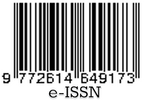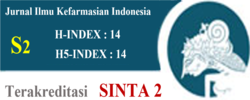Pengaruh Polimer dan Peningkat Penetrasi Terhadap Karakter Penetrasi Matriks Sediaan Patch Transdermal Karvedilol
Abstract
Carvedilol is β-blocker antihypertensive drug with low oral bioavaibility and short half time which causes the frequency of oral drug used more often or the oral dose might be increased. Transdermal patch with the matrix system can deliver drug through skin in controlled within specifi c time period and hopefully it can improve carvedilol bioavaibility and convenience for patients.The aim of research was to fi nd out the effect of polymer and penetration enhancer toward penetration characteristic of carvedilol transdermal patch matrix seen from kinetics release data and penetration data of carvedilol. The polymer ratio of Polyvinyl Alcohol (PVA) : Ethyl cellulose (ES) polymers and Sorbitan Monolaurate (SM) as penetration enhancer concentrations used were F1 (1:1) / 8%, F2 (1: 1) /10%, F3 (2:1) /8%, F4 (2:1)/10%. Formula F1 did not pass in the organoleptictes so next test only carried out for formula F2, F3 and F4. The in vitro release of carvedilol showed formula F2, F3 and F4 lasted for 24 hours and the released kinetics of carvedilol followed the order of 0 and Higuchi. Carvedilol % cumulative from penetration test in vitro showed for F2, F3 and F4 formulas respectively were 15,384%, 16,495% and 18,287%.
References
2. Ubaidulla, U., Reddy, M. V., Ruckmani, K., Ahmad, F.J., & Khar, R. K. (2007). Transdermal therapeutic system of carvedilol: effect of hydrophilic and hydrophobic
matrix on in vitro and in vivo characteristics.
AAPSPharmSciTech, 8(1), E13-E20.
3. Allen, L., & Ansel, H. C. (2013). Ansel’s pharmaceutical dosage forms and drug delivery systems. Philadhelpia: Lippincott Williams & Wilkins, 295.
4. Sharma, K., Singh, V., & Arora, A. (2011). Natural biodegradable polymers as matrices in transdermal drug delivery. International Journal of Drug Development & Research, 3(2), 85-103.
5. Wise, D. L. (2000). Handbook of Pharmaceutical Controlled Release Technology. New York: Marcell Dekker.
6. Pandey, A., Mittal, A., Chauhan, N., & Alam, S. (2014). Role of Surfactants as Penetration Enhancer in Transdermal Drug Delivery System. J Mol Pharm Org Process Res, 2(113),
7. López, A. F. C. M., Llinares, F., Cortell, C., & Herraez, M. (2000). Comparative enhancer effects of Span® 20 with Tween® 20 and Azone® on the in vitro percutaneous penetration of compounds with different lipophilicities.International journal of pharmaceutics, 202(1), 133-140.
8. Sonjoy, M., Thimmasetty, J., Ratan, G. N., & Kilarimath, B. H. (2011). Formulation and evaluation of Carvedilol transdermal patches. Int Res JPharm, 2(1), 237-48.
9. Mounika, K., Reddy, B.K., Reddy, K.N., (2014). Formulation And Evaluation Of Carvedilol Transdermal Patches With Hydrophilic Polymers. World Journal of Pharmaceutical Research, Vol 3, Issue 10, 2014
10. Su, G., Cai, H., Zhou, C., & Wang, Z. (2007). Formation of Edible Soybean and Soybean-Complex Protein Films by a Cross-Linking Treatment with a New Streptomyces Transglutaminase. Food Technology & Biotechnology,45(4).
11. Kharjul, et al, (2012). Formulation , Characterization And Evaluation (InvivoInvitro Study Of Matrix Type Transdermal Patches Of Carvedilol) International Journal Of Research In Pharmacy And Chemistry,2(3), 830.
12. Nandy, et al, (2011), Effect of Various Polymers on Carvedilol Transdermal Films: In- vitro Permeation Studies, Pelagia Research Library Der Pharmacia Sinica, 2011, 2 (4):203-217:
13. Dey dan Malgope,2010 Dey, S., & Malgope, A. (2010). Preparation of carvedilol transdermal patch and the effect of propylene glycol on permeation. International Journal of Pharmacy and Pharmaceutical Sciences, 2, 137–143.
14. Ketema, G., & Sankar, D. G. (2012). RP-HPLC Method for Estimation of Carvedilol in Pharmaceutical Dosage Forms. Am. J. Pharm Tech Res, 2, 513-521.
15. Madhulatha, A., & Naga Ravikiran, T. (2013). Formulation and evaluation of Ibuprofen Transdermal patches. International Journal of Research in Pharmaceutical and Biomedical Sciences, 4(1), 351- 362.
16. Indrati, O., Nugroho, A.,. (2012). Pengaruh Asam Oleat, Propilen Glikol Dan Isopropil Alkohol Pada Formula Patch Transdermal Kalium Losartan Dengan Matriks Hidroksipropil Metilselulosa Dan Etil Selulosa (Doctoral dissertation, Universitas Gadjah Mada).
17. Bernal-Ballén, A., Kuritka, I., & Saha, P. (2016). Preparation and Characterization of a Bioartifi cial Polymeric Material: Bilayer of Cellulose Acetate-PVA. International Journal of Polymer Science, 2016.
18. Mukherjee, B., Kanupriya, M. S., Das, S., & Patra, B. (2005). Sorbitan monolaurate 20 as a potential skin permeation enhancer in transdermal patches. J Appl Res, 1, 96-108.
19. Saxena, J. (Ed.). (2013). Hazard assessment of chemicals: current developments. Elsevier.
20. Bharkatiya, M., Nema, R. K., & Bhatnagar, M. (2010). Designing and characterization of drug free patches for transdermal application.International Journal of Pharmaceutical Sciences and drug research, 2(1), 35-39.
21. Smith, E. W., & Maibach, H. I. (Eds.). (2005). Percutaneous Penetration Enhancers. CRC Press. London
22. Yoo, Y., Shin, H. W., & Nam, B. G. (2003). Effect of hydrophilic-lipophilic balance of drugs on their release behavior from amphiphilic matrix.Macromolecular research, 11(4), 283-290.
23. Ali, T., Shoaib, M. H., Yousuf, R. I., Jabeen, S., Muhammad, I. N., & Tariq, A. (2014). Use of hydrophilic and hydrophobic polymers for the development of controlled release tizanidine matrix tablets. Brazilian Journal of Pharmaceutical Sciences, 50(4), 799-818.
24. Sinko, P. J., Allen Jr, L. V., Popovich, N. G., & Ansel, H. C. (Eds.). (2006). 1: 1.Martin’s Physical Pharmacy and Pharmaceutical Sciences.
25. Taghizadeh, M. (2013). Thermal degradation behavior of polyvinyl alcohol/starch/carboxymethyl cellulose/ clay nanocomposites. Universal Journal of Chemistry, 1(2), 21-29.
26. R o w e , R . C ( 2 0 1 0 ) . H a n d b o o k o f PharmaceuticalExcipients.London:Pharmaceutical Press.
Licencing
All articles in Jurnal Ilmu Kefarmasian Indonesia are an open-access article, distributed under the terms of the Creative Commons Attribution-NonCommercial-ShareAlike 4.0 International License which permits unrestricted non-commercial used, distribution and reproduction in any medium.
This licence applies to Author(s) and Public Reader means that the users mays :
- SHARE:
copy and redistribute the article in any medium or format - ADAPT:
remix, transform, and build upon the article (eg.: to produce a new research work and, possibly, a new publication) - ALIKE:
If you remix, transform, or build upon the article, you must distribute your contributions under the same license as the original. - NO ADDITIONAL RESTRICTIONS:
You may not apply legal terms or technological measures that legally restrict others from doing anything the license permits.
It does however mean that when you use it you must:
- ATTRIBUTION: You must give appropriate credit to both the Author(s) and the journal, provide a link to the license, and indicate if changes were made. You may do so in any reasonable manner, but not in any way that suggests the licensor endorses you or your use.
You may not:
- NONCOMMERCIAL: You may not use the article for commercial purposes.
This work is licensed under a Creative Commons Attribution-NonCommercial-ShareAlike 4.0 International License.





 Tools
Tools





















